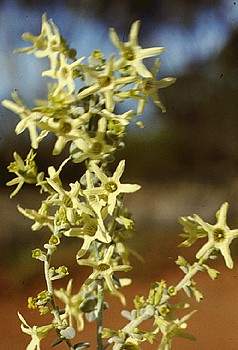Taxonomy
Cyphanthera Miers, Ann. Mag. Nat. Hist. ser. 2, 11: 376 (1853); from the Greek kyphos (bent or humped), and anthera (an anther), in reference to the horseshoe-shaped unilocular anthers.
Eadesia F. Muell., Trans. & Proc. Philos. Inst. Victoria 2: 71 (1858).
Anthocercis Labill. sect. Cyphanthera (Miers) F. Muell., Fragm. Phytogr. Austral 2: 138 (1861).
Type species: not designated.
[Anthocercis auct. non Labill., e.g. A. Cunningham, in B. Field (ed.), Geogr. Mem. New South Wales 335, t. 2, 3 (1825).]
Shrubs, tomentose with non-glandular hairs or pubescent with mainly glandular hairs, or almost glabrous. Leaves alternate, simple, sessile, rarely petiolate. Inflorescence cyme-, raceme-, panicle- or thyrse-like, terminal or lateral; or flowers solitary, terminal, leaf-opposed, inter-foliar or in branch forks. Flowers bisexual, actinomorphic or slightly zygomorphic, with or without subtending pairs of bracts. Calyx campanulate to cupular, 5–lobed. Corolla funnel-shaped to campanulate with spreading limb, white to pale yellow, striated in tube; limb 5–lobed, the lobes induplicate in bud. Stamens 4, didynamous, inserted at base of corolla-tube; a staminode sometimes present; anthers unilocular, not cohering, dehiscing by a terminal, semicircular slit. Ovary bilocular; stigma capitate, very shortly bilobed. Fruit a smooth capsule, opening from apex by 4 valves, at least the lower half enclosed by calyx. Seeds subreniform. n=30.
A genus of 9 species endemic in southern temperate Australia.
J. Miers, On the genera of the tribe Duboisieae, Ann. Mag. Nat. Hist. ser. 2, 11: 375–381 (1853); L. Haegi, A conspectus of Solanaceae tribe Anthocercideae, Telopea 2: 173–180 (1981).
Changes since the Flora of Australia treatment
There have been no changes in the number of species since the Flora of Australia treatment.
Phylogenetic studies by Garcia & Olmstead (2003) on the Tribe Anthocercideae using two chloroplast DNA regions indicated that Cyphanthera and Duboisia are not monophyletic and these genera may need to be recircumscribed in the future. Cyphanthers odgersii showed a closer relationship to Grammosolen while the rest of the Cyphanthera species combined to form a clade with Duboisia and Crenidium.
Anthocercis, Anthotroche, Grammosolen and Symonanthus were shown to be monophyletic.
Reference: V.F.Garcia & R.G.Olmstead (2003). Phylogenetics of Tribe Anthocercideaea (Solanaceae) based on ndhF and trnL/F sequence data. Systematic Botany 28: 609-615.
Key to species
Key from Flora of Australia 29: 22 (1982).
1 Branches, leaves and calyx-lobes densely woolly-tomentose; flowers in dense woolly clusters, often in leafy spikes
Cyphanthera odgersii
1: Branches, leaves and calyx-lobes not woolly-tomentose; flowers solitary, in cymes, thyrses, or narrow, leafy, panicle-like inflorescences
2 Upper branches densely (sometimes sparsely) tomentose with mostly dendritic, non-glandular hairs
3 Inflorescence a thyrse; corolla-lobes broad and rounded
Cyphanthera racemosa
3: Flowers solitary or in few-flowered cymes, or inflorescence panicle-like, narrow, leafy; corolla-lobes long and narrow
4 Flowers solitary or in distant cymes
Cyphanthera scabrella
4: Flowers in leafy, panicle-like inflorescences
5 Leaves almost glabrous or sparsely pubescent, the margins flat, midrib not indented above
Cyphanthera anthocercidea
5: Leaves moderately to densely pubescent, the margins slightly inrolled, midrib indented above
6 Stalked, stellate-dendritic hairs absent from stems; secondary veins of leaves obscure
Cyphanthera albicans
6: Stalked, stellate-dendritic hairs common on stems; secondary veins of leaves conspicuous at least on lower surface
Cyphanthera tasmanica
2: Upper branches sparsely to moderately pubescent with mostly simple or forked, glandular hairs (hairs sometimes decapitated, but branches then viscid), or with scattered, weak, dendritic hairs, or glabrous
7 Branches and leaves not viscid; flowers in thyrses; leaves mostly more than 10 mm long
Cyphanthera racemosa
7: Branches and leaves viscid; flowers solitary or in few-flowered cymes; leaves mostly less than 10 mm long
8 Leaves triangular-cordate, the bases subauriculate
Cyphanthera miersiana
8: Leaves ovate, elliptic or oblong, the bases cuneate or rounded
9 Mature leaves to 2.2 mm long, more or less appressed to stem; filaments glabrous
Cyphanthera microphylla
9: Mature leaves 2–10 mm long, spreading to oblique; filaments pubescent at base
Cyphanthera myosotidea



